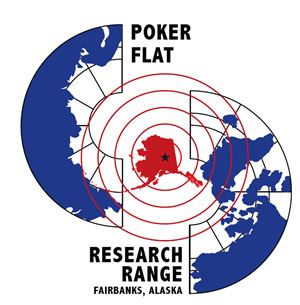Busy rocket season to launch at Poker Flat Research Range
Busy rocket season to launch at Poker Flat Research Range
Submitted by Amy Hartley
Phone: 907-474-5823
01/09/09

A total of eight National Aeronautics and Space Administration sounding rockets will launch from Poker Flat Research Range in 2009. The rocket season is split into two launch windows. The first launch window opens Jan. 10, and will remain open until Feb. 5, 2009.
The first window will see the launch of three rockets as part of two separate missions. One mission will aid scientists’ study of the ionosphere, while the other will gather data on the structure of auroral arcs.
The Ionospheric Science and Inertial Sensing project, called ISIS for short, will be the first to fly. This is a University of Alaska Fairbanks student rocket project funded by the Alaska Space Grant Program. It aims to measure the plasma density structure of the high latitude D-region of the ionosphere. The ISIS team anticipates their rocket to launch at 2 p.m. Alaska Standard Time on Jan. 10, so long as winds remain stable.
The 147-pound ISIS payload will fly aboard an Orion sounding rocket that will fly up to 57 vertical miles in 2.5 minutes. Ten students have developed the instrumentation and payload under the guidance of principal investigator Denise Thorsen, Alaska Space Grant Program director, and Joe Hawkins, a UAF professor of electrical and computer engineering. This will be the Alaska Student Rocket Program’s fifth rocket to launch from Poker Flat since 1992.
The second mission is called ACES, or Auroral Current and Electrodynamics Structure. It includes two separate vehicles that will fly through different sections of an auroral arc. The two-stage Black Brant IX will launch first, expected to reach the top edge of an aurora display at more than 200 vertical miles. Just one-and-a-half minutes later, the single-stage Black Brant V will lift off. Its goal is to reach the lower edge of the same auroral arc. By measuring the top and base of the aurora simultaneously, scientists hope to gain a clearer picture of aurora structure.
Scott Bounds from the Department of Physics and Astronomy at the University of Iowa is the principal investigator for the ACES project, which was initiated in 2007.
Poker Flat Research Range will open a second launch window Feb. 12, 2009 that will include two more experiments with a total of five rockets of various sizes. The scientists overseeing these missions are from Dartmouth College and Clemson University.
Since atmospheric conditions must be just right prior to launch, specific times are not typically set for rocket launches. Therefore, rockets are loaded onto launchers and ready to fly at any time during launch windows. The general public is not permitted on Poker Flat Research Range during rocket launches. However, the public may view rocket launches and activity from several vantage points near the range.
Poker Flat Research Range is the largest land-based sounding rocket range in the world. It’s located 30 miles north of Fairbanks on the Steese Highway. The Geophysical Institute at UAF operates the range under contract to NASA. More than 300 major scientific sounding rockets have launched from the facility since it was founded in 1969.
CONTACT: Poker Flat Research Range at 907-455-2110. Geophysical Institute information officer Amy Hartley at 907-474-5823 or amy.hartley@gi.alaska.edu.
ON THE WEB: www.gi.alaska.edu/pfrr


